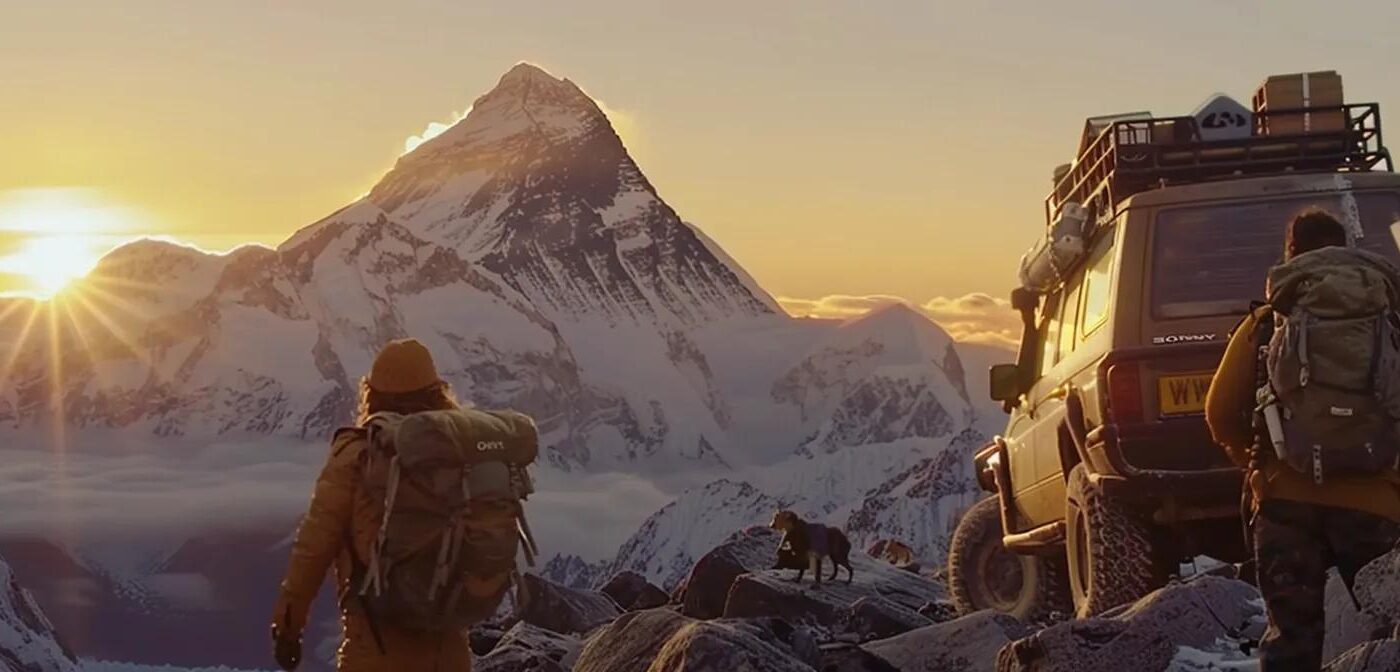
Climbing Mount Everest: Essential Guide for Adventurers
Climbing Mount Everest is a dream for many adventurers, yet it comes with challenges that can deter even the most determined. With a rich history marked by figures like Lydia Bradey and Rob Hall, the journey demands rigorous preparation and understanding of various climbing routes. This guide will cover essential aspects, including preparation tips, necessary permits, and insights into the climbing experience. By reading this content, adventurers will learn how to enhance their endurance and tackle common obstacles, ensuring a safer and more fulfilling ascent.
Understanding Mount Everest
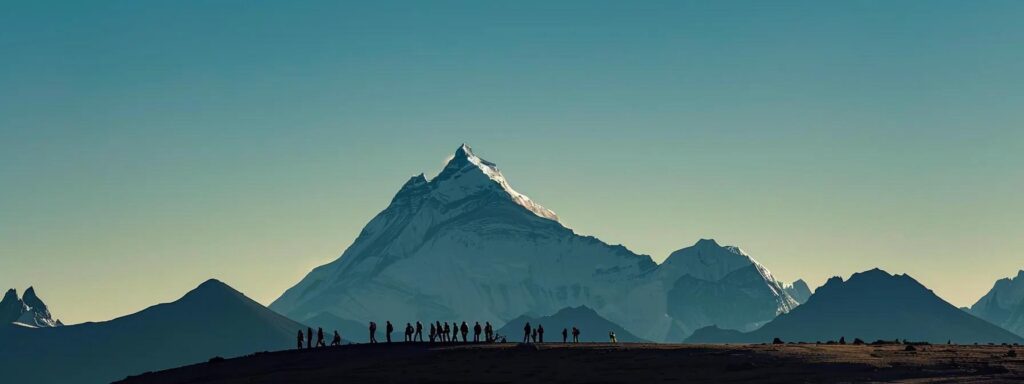
Mount Everest, known as the highest mountain on Earth, holds immense significance for climbers and adventurers alike. Located in the Himalayas, it boasts unique features such as the Rongbuk Glacier, which offers a challenging ascent. The mountain is also referred to as Sagarmatha in Nepal and Chomolungma in Tibet. This section will cover its geographic location, notable altitudes, and historical context, including Maurice Herzog‘s groundbreaking ascent.
Overview of Mount Everest’s Significance
The significance of Mount Everest extends beyond its status as the highest peak on Earth, attracting climbers striving for success. Adventurers face challenges like rapidly changing weather conditions and the need for supplemental oxygen, which intensifies the ascent. The mountain’s surrounding features, such as the Pumori peak, provide a stunning backdrop while also presenting opportunities for ice climbing, making it a prime focus for researchers, including those from the National Geographic Society. Understanding the environmental impact, especially the melting glaciers and carbon footprint associated with climbing, is essential for preserving this remarkable natural wonder for future generations.
Geographic Location and Features
Mount Everest, located in the Himalayas near Kathmandu, stands as the highest point on Earth with an elevation of 8,848.86 meters. This iconic mountain features the notorious Hillary Step, a nearly vertical rock face that demands precise climbing skills, and poses significant challenges for climbers. In addition, the increasing presence of plastic waste left by adventurers highlights the urgent need for sustainable practices during expeditions, ensuring that this magnificent peak remains a respected environment as climbers like Peter Habeler and others have ascended its heights with great ambition.
Other Names for Mount Everest
Mount Everest is known by various names that reflect its cultural significance and geographic identity. In Nepal, it is called “Sagarmatha,” while in Tibet, it is known as “Chomolungma.” These names highlight not only its majestic height of 8,848.86 meters above sea level but also its connection to the local communities. As climbers prepare for the Mt Everest base camp hike, understanding these names offers insight into the mountain’s revered status and prompts respect for the traditions surrounding this iconic peak.
Preparing for Climbing Mount Everest
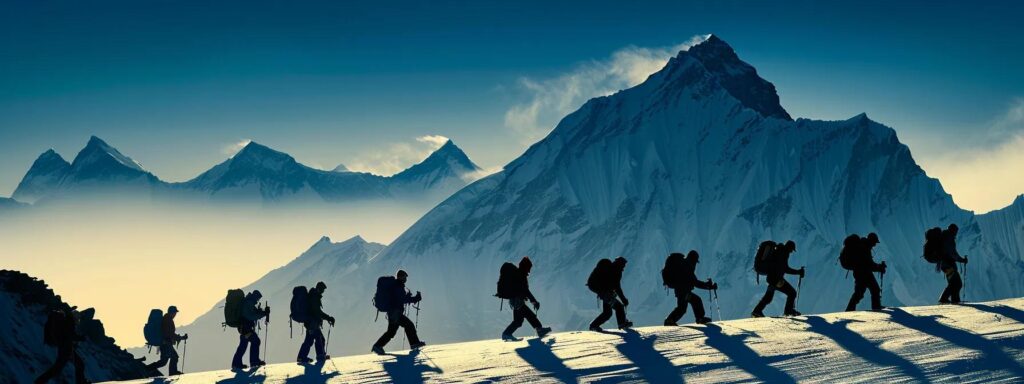
Preparing for climbing Mount Everest requires a comprehensive approach, covering essential gear and equipment, physical conditioning, and mental preparation. Aspiring climbers should explore training programs tailored for their skill level while gaining a solid understanding of climbing seasons. Insights into the Everest Base Camp trek cost and historical figures like Andrew Irvine and Ueli Steck can enrich this experience and enhance overall happiness in achieving such a monumental goal.
Essential Gear and Equipment
When preparing to climb Mount Everest, selecting the right gear and equipment is essential for ensuring safety and success at high altitudes, where atmospheric pressure is significantly lower. Adventurers often rely on expert advice from adventure consultants to choose the best lightweight yet durable clothing, climbing gear, and proper footwear that can withstand the challenges posed by metamorphic rock and ice. Furthermore, climbers should be mindful of the potential for injuries related to physical exertion, including muscle strain as they navigate through the mountain’s intricate fault lines, making appropriate equipment choices vital for a successful ascent.
Physical Conditioning for Climbers
Physical conditioning is paramount for aspiring climbers looking to conquer Mount Everest. Proper training should focus on building endurance, strength, and flexibility tailored to high-altitude environments. Incorporating exercises that simulate uphill hiking, such as stair climbing or navigating the rugged terrain indicated in the Himalayan database, helps prepare the body for the demands of the ascent. Additionally, studying the experiences of renowned climbers like Junko Tabei, who became the first woman to reach the summit, provides valuable insights into the importance of rigorous training and mental fortitude. By documenting their climbs through photographs, climbers can also visually track their progress and identify areas that need improvement, further enhancing their readiness to face the challenges posed by the tectonics of the region.
Mental Preparation Tips
Mental preparation is a crucial aspect for climbers aiming to conquer the challenges of Mount Everest. Understanding the daunting terrain, particularly sections like the Geneva Spur, demands not only physical strength but also mental resilience. Climbers should engage in visualization techniques, mentally rehearsing the ascent and strategizing on how to handle crucial moments, such as navigating steep hills. Furthermore, maintaining proper nutrition both during training and while climbing is essential, as it supports endurance and cognitive function, helping climbers make sound decisions even in the demanding conditions found on mountains like Dhaulagiri.
Training Programs for Aspiring Climbers
Training programs for aspiring climbers planning to conquer Mount Everest should incorporate rigorous physical conditioning and education on high-altitude challenges. These programs can include techniques to adapt to the changing climate, implementing the use of supplemental oxygen masks, and practicing skills like navigating fixed ropes used during ascents. Collaborating with experienced guides from the Sherpa people, who possess invaluable knowledge of the mountain, enriches these training sessions and prepares climbers for the realities of the terrain, ultimately increasing their chances of a safe and successful expedition.
Understanding Climbing Seasons
Understanding climbing seasons on Mount Everest is crucial for any adventurer planning the ascent. Typically, the most favorable time to tackle the challenging routes, including the treacherous Khumbu Icefall and the South Col, is during the pre-monsoon period from April to early June. Climbers must be prepared to face potential fears related to rapid weather changes and the physical demands as they reach the summit, especially after acclimatizing in areas like Lukla. Conversely, the post-monsoon season, while less popular, can offer an alternative route, albeit fraught with risks similar to those encountered on peaks like Nanga Parbat.
Climbing Routes on Mount Everest
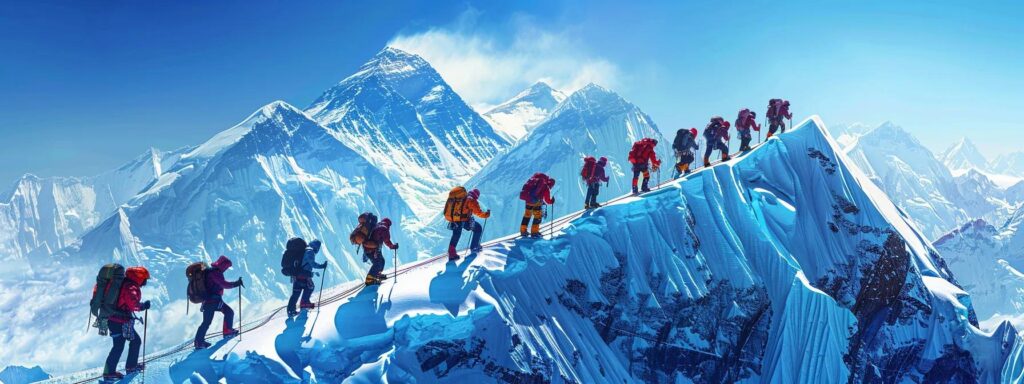
Climbing Routes on Mount Everest
The climbing routes on Mount Everest present varied challenges and opportunities for climbers. Detailed descriptions of popular routes, such as the South Col and North Ridge, will be explored, offering a comparison of their unique features. The discussion will also cover challenges climbers may face along these paths, emphasizing the importance of selecting a route that aligns with individual skill levels. Additionally, insights into the effects of altitude disease, geological features, and nearby landmarks like Ama Dablam and the Kosi River will enhance the understanding of these ascents.
Detailed Description of Popular Routes
The South Col and North Ridge routes are two of the most well-known paths for climbers attempting Mount Everest. The South Col route, often favored for its established trail and proximity to the base camp, leads through the challenging Khumbu Icefall, where the use of crampons is essential for navigating icy terrain. Alternatively, the North Ridge offers a more technical ascent, requiring climbers to manage the risks of altitude sickness while dealing with steep sections, making the choice of route a critical factor in their success.
Comparison of South Col and North Ridge
The comparison between the South Col and North Ridge routes on Mount Everest highlights distinct risks and challenges for climbers. The South Col route, while popular and often preferred for its established trails, still presents significant dangers, particularly in navigating the arduous Khumbu Icefall. On the other hand, the North Ridge offers a more technical climb, requiring advanced skills and a strong mindset to manage altitude sickness and steep ascents. Adventurers like Reinhold Messner emphasize the need for mental fortitude in overcoming these challenges, as the right approach can significantly impact climbers’ success on this iconic peak—a goal that can often feel as elusive as a goose in flight.
Navigating Challenges Along the Routes
Navigating the challenges along the routes of Mount Everest requires careful adaptation to the unique conditions climbers face. Climbers must manage the risks posed by the rocky schist formations at high altitudes, which can be unexpectedly treacherous. Those preparing for a Mount Everest trip should be aware that ascending to altitudes above 8,000 metres presents significant hazards, and familiarity with techniques used in the Alps can offer invaluable insights into tackling these demanding terrains effectively.
Choosing the Right Route for Your Skill Level
Choosing the right route to climb Mount Everest is vital for ensuring a safe and successful ascent, especially for those planning to climb Everest Base Camp. Climbers must assess their skill level against the challenges presented by routes like the South Col and North Ridge, taking into account factors such as altitude acclimatization and the impact of microplastics left behind by previous expeditions. Aspiring climbers can benefit from research conducted by organizations like the Royal Geographical Society, which provides valuable insights into both the technical requirements of different paths and the environmental considerations that arise from climbing on the Tibetan Plateau.
Permits and Regulations for Mount Everest Climbing
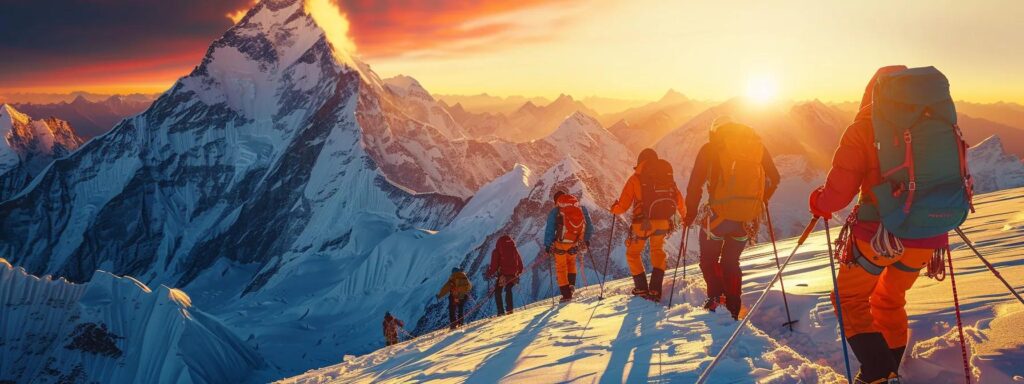
Climbing Mount Everest requires a clear understanding of the necessary permits and regulations. This section outlines the overview of required permits for the summit, details the application process and associated fees, and discusses the legal regulations climbers must follow. The role of guides and Sherpas is also emphasized, showcasing their importance in navigating the high-pressure environment of Everest, especially when compared to giants like Kangchenjunga and Manaslu.
Overview of Required Permits
Climbing Mount Everest necessitates acquiring specific permits to ensure compliance with regulations and maintain safety during expeditions. For climbers wishing to reach the summit, the required permit involves a substantial fee, significantly influencing the everest base camp trek price. With renowned climbers like Kami Rita holding records for summits, adventurers must recognize the necessity of permits in safeguarding both climbers and the environment, including the proper use of oxygen masks to enhance safety at high altitudes, similar to regulations observed on other peaks like Denali. Understanding these requirements not only fosters respect for local cultures, including Buddhism, but also prepares climbers for the complex process of securing their place among the legends of Everest.
Application Process and Fees
The application process for climbing Mount Everest requires aspiring climbers to obtain various permits, which involve specific fees that can substantially increase the overall cost of their adventure. For those looking to make their way from Namche Bazaar to the Everest Base Camp, understanding these financial responsibilities is essential, particularly when working with well-regarded guides like Scott Fischer, who can provide insight into the requirements. Climbers should expect to budget for not only the permits but also additional expenses related to acclimatization and logistics, especially concerning the weather station data that is critical for planning the climb.
Legal Regulations for Climbers
Legal regulations for climbers attempting to reach Mount Everest focus on ensuring safety and respect for the mountain’s environment. Adventurers must comply with strict guidelines regarding acclimatization, especially when navigating the perilous death zone, where altitude sickness becomes a significant risk. Historical figures like Edmund Hillary have highlighted the importance of supporting regulations that promote responsible climbing, paralleling challenges faced on nearby peaks like Cho Oyu, suggesting that a well-planned experiment of proper training and adherence to these laws can considerably enhance a climber’s chances of success on the ridge.
Role of Guides and Sherpas
The role of guides and Sherpas in the Mount Everest climbing experience is paramount for ensuring safety and success during the expedition. Their extensive knowledge of the region, including the challenging terrain that climbers face while navigating the base camp Everest hike, allows them to provide crucial support at high altitudes. For instance, climbers like Cory Richards often emphasize the importance of having a skilled guide who can skillfully handle equipment such as an ice axe while familiarizing climbers with the unique challenges posed by the Tibetan side of the mountain, ultimately enhancing the overall climbing experience.
The Climbing Experience on Mount Everest
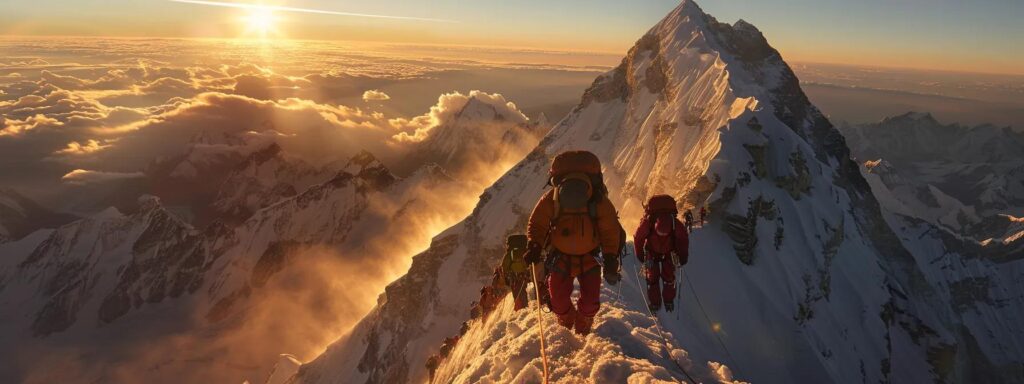
The climbing experience on Mount Everest involves several key elements critical for success. Adventurers must navigate essential camps, each serving vital roles in the ascent. Strategies for the summit push, the use of supplementary oxygen, and understanding risks and hazards are crucial topics to address. Through the stories of climbers, insights into the challenges faced at this height on the “roof of the world” provide valuable perspectives on the journey through this majestic mountain range.
Key Camps and Their Roles
Key camps on Mount Everest serve as crucial waypoints for climbers facing the rigors of high-altitude ascent. Each camp, including Base Camp and higher camps like Camp 1 and Camp 2, provides necessary rest, oxygen supply, and acclimatization opportunities essential for combating the thin atmosphere at these elevations. Understanding their roles can enhance a climber’s experience, as exemplified by climbers like Jordan Romero and Nirmal Purja, who relied on proper preparation at these camps for their successful ascents, all while balancing energy needs—sometimes satisfied with diverse meals, including Indian cuisine.
Summit Push Strategies
Summit push strategies on Mount Everest are critical for climbers aiming for success at extreme altitudes. Acclimatization plays a vital role in these strategies, allowing climbers to adapt to the thin air and reduce the risk of altitude sickness, which was famously mastered by legends like Tenzing Norgay and Tom Hornbein. Climbers should establish a plan that includes sufficient rest at key locations, such as near the lakes in the Tibet Autonomous Region, enabling them to regain strength before tackling the final ascent to the summit.
Risks and Hazards on the Mountain
The risks and hazards of climbing Mount Everest are significant and can pose severe challenges to even the most experienced adventurers. Climbers must remain vigilant about potential dangers such as crevasses and seracs, which can cause serious accidents if not navigated carefully. Historical encounters, like those involving Raymond Lambert, highlight the importance of preparation and knowledge in the face of these threats. Moreover, the Government of Nepal has implemented regulations to enhance safety, often influenced by research from organizations like National Geographic, that emphasizes the need for proper acclimatization and strategic planning to minimize risk during the ascent.
Supplementary Oxygen Use
Supplementary oxygen use is a crucial aspect of climbing Mount Everest, particularly in sections like the Western Cwm and above the Khumbu Glacier. As climbers ascend, the decrease in atmospheric pressure significantly affects breathing and the body’s ability to obtain oxygen, leading to adverse effects of high altitude on humans. Many climbers employ oxygen masks to combat these challenges, ensuring adequate breathing and maintaining physical endurance, especially during the Ming Kipa phase of their ascent.
Climbers’ Experiences and Stories
Climbers attempting to reach the summit of Mount Everest often share their experiences of navigating its unique geography, facing challenges like fatigue and harsh weather conditions. For those who participate in the Mt Everest Base Camp trek, understanding the importance of logistics becomes essential, as proper planning can greatly impact their overall success and safety. Additionally, integrating reliable weather forecasting into their preparation allows climbers to anticipate changes that could affect their journey, further enhancing their chance of achieving a successful ascent.
After the Climb: Reflecting on Achievements
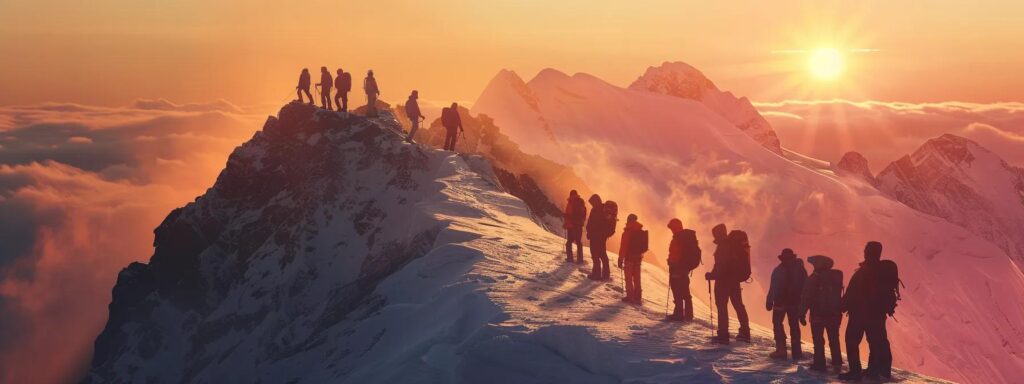
After reaching the summit of Mount Everest, climbers face a significant moment of reflection on their achievements. This section discusses celebrating accomplishments, managing post-expedition effects, and sharing experiences with others. Additionally, it highlights valuable lessons learned during the climb, emphasizing the importance of recognizing the natural environment and energy required to conquer this challenge among the seven summits. Through these insights, adventurers can find deeper meaning in their journey.
Celebrating Your Accomplishment
After conquering Mount Everest, climbers like Adrian Ballinger often take a moment to appreciate their achievements, recognizing the dedication and effort required to navigate the challenges posed by the icefall and unpredictable weather conditions. Celebrating this moment can take many forms, from sharing stories of the ascent in the Bay of Bengal to reflecting on the technical skills developed during the climb, such as those necessary for tackling Makalu‘s steep routes. Whether through personal reflection or communal celebrations, acknowledging these accomplishments fosters a deeper connection to the journey undertaken and highlights the value of their experiences on this remarkable mountain.
Dealing With Post-Expedition Effects
After an expedition to Mount Everest, climbers often face various post-expedition effects, including physical stress and emotional challenges. The physical toll may include dealing with altitude sickness or fatigue, particularly from regions like the Kangshung Face, known for its demanding ascent. Additionally, the reality of pollution and environmental changes in the region can cause stress, which climbers must address as they reflect on their experiences amidst the stunning Himalayan landscape, balancing their personal achievements against the broader context of environmental preservation.
Sharing Your Journey With Others
Sharing the journey of climbing Mount Everest allows adventurers to connect with others and inspire future climbers. Discussing experiences in the Khumbu region, from setting up a tent at Base Camp to navigating the challenges posed by glaciers, can provide valuable insights for those considering an Everest expedition. Moreover, understanding how plate tectonics have shaped the mountain adds depth to these narratives, allowing climbers to educate others about the natural forces that influence their remarkable achievements, while being mindful of the ever-changing Everest expedition cost that many aspiring climbers must navigate.
Lessons Learned From Climbing Mount Everest
Climbing Mount Everest teaches invaluable lessons that extend beyond the physical ascent, emphasizing the importance of preparation and environmental awareness. For instance, climbers often experience hypoxia— a condition caused by insufficient oxygen at high altitudes— which highlights the need for effective acclimatization strategies. Additionally, understanding the technical differences between peaks like Lhotse and Annapurna can inform decisions made on the south summit, enabling adventurers to navigate their challenges more effectively and safely.
Frequently Asked Questions About Climbing Mount Everest
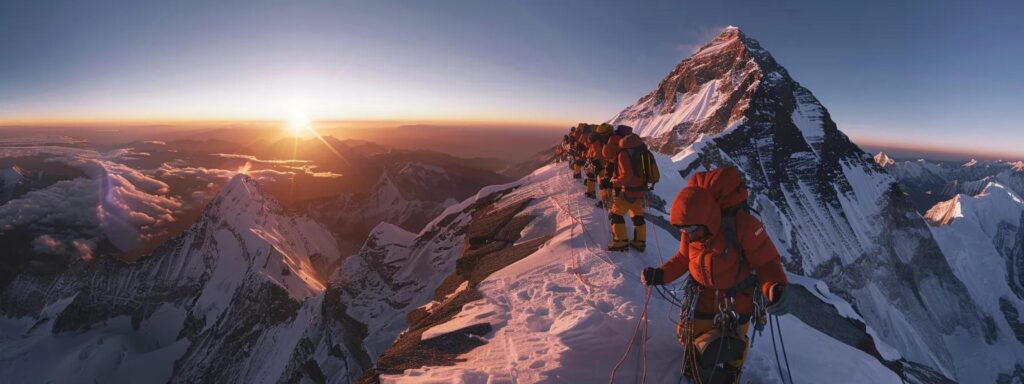
Frequently Asked Questions About Climbing Mount Everest
This section addresses common inquiries related to climbing Mount Everest, providing essential insights for adventurers. Key topics include the best time to climb the mountain, the challenges posed by altitude, including concerns like frostbite, and an explanation of the death zone. Additionally, readers will learn about accessibility for climbers and necessary preparations before the journey, ensuring a comprehensive understanding of traversing this granite giant.
What Is the Best Time to Climb Mount Everest?
The best time to climb Mount Everest typically falls within the pre-monsoon period, from late April to early June, when weather conditions are most favorable. During this time, climbers benefit from stable weather patterns that reduce the risk of avalanches and improve visibility among the gneiss and limestone formations on the mountain. It is crucial for adventurers to understand these seasonal dynamics, especially around critical areas like the North Col, to ensure safety and optimize their chances of reaching the summit while navigating the treacherous valleys below.
How Hard Is It to Climb Mount Everest?
Climbing Mount Everest is a formidable challenge that requires extensive preparation and specialized gear. Factors such as extreme altitude, unpredictable weather conditions, and the impacts of climate change complicate the ascent, making it crucial for climbers to rely on ropes and buffers for safety while navigating treacherous terrain. As global tourism increases to this iconic mountain, understanding the risks and demands of the climb becomes vital for anyone considering this extraordinary adventure.
What Is the Death Zone?
The term “Death Zone” refers to altitudes above 8,000 meters (26,247 feet) on Mount Everest, where the oxygen level is insufficient for human survival, severely affecting climbers’ physical abilities. In this zone, factors such as extreme wind conditions and the unpredictable weather patterns common to the Solukhumbu District can complicate ascents and increase risks. The challenges of climbing in the Death Zone highlight the importance of proper acclimatization and preparation, advocating for climbers to prioritize safety while capturing the breathtaking photography opportunities that the region offers, whether from a helicopter or amidst the stunning landscapes of the plateau.
Can Anyone Climb Mount Everest?
Climbing Mount Everest is an extraordinary achievement, but it is not suitable for everyone. Those looking to summit must possess strong rock climbing skills and physical conditioning, as the ascent involves navigating challenging terrains, including the infamous ladders used to cross crevasses. Hiring an experienced mountain guide is essential, as they provide critical insight on acclimatization and managing partial pressure at high altitudes, which directly impacts a climber’s ability to function effectively. Furthermore, for individuals considering the climb as a unique gift, a climbing experience gift card can be an inspiring way to motivate aspiring adventurers, though one should ensure they are adequately prepared for such a demanding journey.
What Should I Know Before Climbing Mount Everest?
Before embarking on a climbing expedition to Mount Everest, adventurers should understand the complexities involved in such a monumental challenge. Knowledge of the first ascent, achieved by Sir Edmund Hillary and Tenzing Norgay in 1953, provides historical context and inspiration. Climbers should also consider practical aspects, such as staying hydrated by using a quality water bottle to address the dry high-altitude climate, and the need for suitable cuisine that supports nutrition during the trek. Familiarity with other prominent peaks, like Aconcagua, can help climbers appreciate the unique demands of Everest while preparing adequately for their journey during mt everest expeditions.
Conclusion
Climbing Mount Everest offers unparalleled challenges and rewards that demand meticulous preparation and respect for the mountain’s unique environment. Adventurers should prioritize essential gear, physical conditioning, and mental resilience to enhance their chances of a successful ascent. Understanding the climbing routes, permits, and environmental impacts is vital for promoting responsible climbing practices. Embracing these insights not only prepares climbers for the ascent but also deepens their appreciation for one of nature’s most magnificent wonders.

